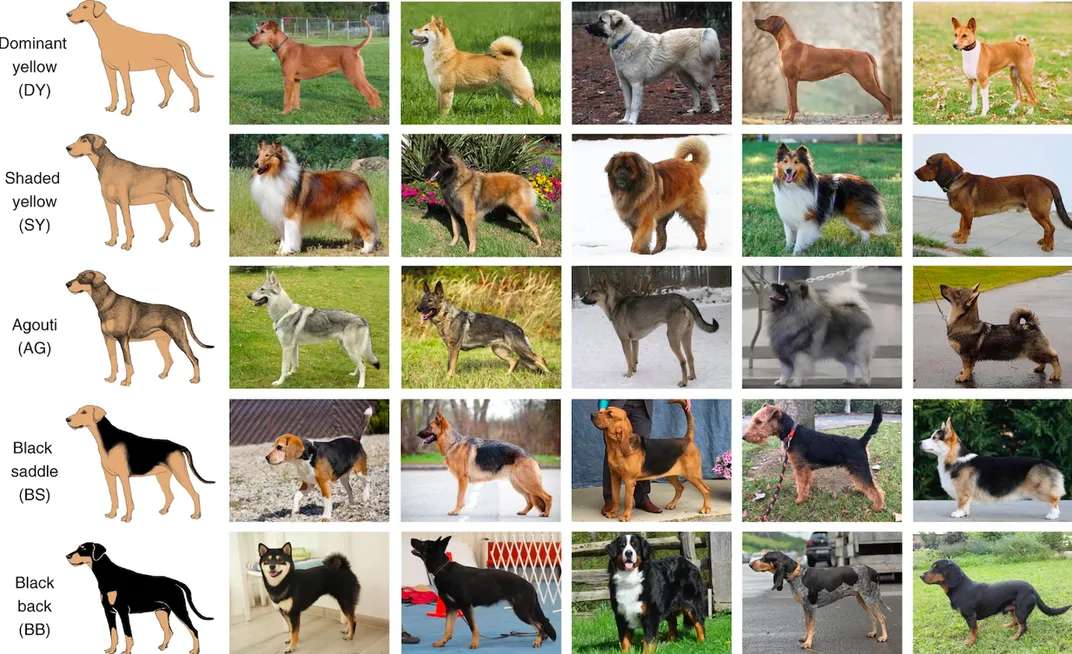Golden Fur in Dogs Evolved Two Million Years Ago, Long Before Domestication
Five coat color variations in domestic canines emerged from an ancient ancestor
:focal(463x136:464x137)/https://tf-cmsv2-smithsonianmag-media.s3.amazonaws.com/filer/40/ef/40efff4c-68a0-4daa-8099-219bf4249bd6/low-res_jiff_resizedjpg.png)
Some breeds of dogs are prized for their unique coat colors, such as the golden retriever's shimmery, amber coat or a blue merle Australian shepherd's speckled fur. Researchers previously thought that the variations in coat color occurred after humans began breeding and domesticating canines. However, in a new study published this month in Nature Ecology and Evolution, researchers found one gene that predates domestication actually produces five common coat color patterns that are still seen in hundreds of breeds today.
The mutations originated in a canid ancestor that diverged from grey wolves about two million years ago, reports Vishwam Sankaran for the Independent. The study may also reveal the origin and evolution of various dog lineages.
Dogs obtain their unique coat colors from a gene called Agouti-signaling protein (ASIP). The gene is responsible for controlling the amount and variation of yellow and black pigments seen in many mammals, reports Newsweek's Samantha Berlin. The yellow tint is called pheomelanin, and the black coloration is called eumelanin. Coat color patterns result from a regulated production of these two pigments, the Independent reports.

Geneticist Danika Bannasch of the University of California, Davis (UC Davis), and her team identified structural variants that control how the ASIP protein is expressed in two different locations on the gene. Mutations along the locations produce five different coat colors in dogs, according to a UC Davis press release.
The five coat color variations, or phenotypes, controlled by the ASIP gene are dominant yellow, shaded yellow, agouti, black saddle, and black back.
The dominant yellow coat pattern is shared with arctic white wolves and ended up in modern-day dogs when the lineage diverged two million years ago before modern wolves evolved, Gizmodo's Issac Schultz reports. The shaded yellow phenotype produced by mutations on the ASIP gene are seen in a collie’s coat color. Agouti occurs when more than one pigment is present on each hair; this pattern is seen on German sheperds, for example. A black saddle phenotype is characterized by a large black patch covering most of a dog's back, which is commonly seen in beagles. Black backs are characterized by a black coat covering most of their body. Sometimes a black-backed dog will have different colored belly or paws. This pattern is seen in breeds like Dachshunds or Bernese mountain dogs.
Lighter coat colors, like dominant yellow and shaded yellow, may have been favorable for the extinct canid ancestor while hunting in the snowy environments during glaciation periods between 1.5 and 2 million years ago—long before canine domestication occurred 30,000 years ago, according to the press release.
"We were initially surprised to discover that white wolves and yellow dogs have an almost identical ASIP DNA configuration," says co-author Chris Kaelin of the HudsonAlpha Institute for Biotechnology in a statement. "But we were even more surprised when it turned out that a specific DNA configuration is more than 2 million years old, prior to the emergence of modern wolves as a species."
Per Newsweek, the lighter fur may have helped ancient wolves approach their prey without being seen. A golden coat color persisted in ancient canids, and the coloring is still observed in modern dogs and wolves. Examples of dominant yellow coat patterns are seen today in Shiba Inu, chow chows, bullmastiffs, and Irish terriers, Gizmodo reports.
Overall, the study gives scientists a better idea of what ancient canines may have looked like, per Gizmodo.
/https://tf-cmsv2-smithsonianmag-media.s3.amazonaws.com/accounts/headshot/gamillo007710829-005_0.png)
/https://tf-cmsv2-smithsonianmag-media.s3.amazonaws.com/accounts/headshot/gamillo007710829-005_0.png)